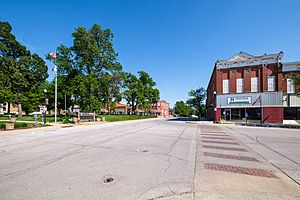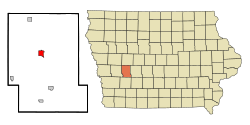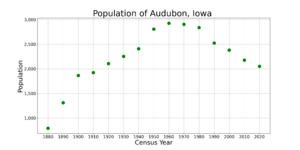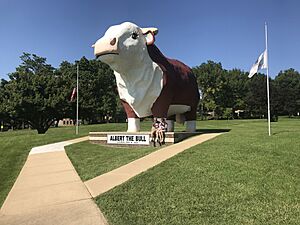Audubon, Iowa facts for kids
Quick facts for kids
Audubon, Iowa
|
|
|---|---|
 |
|

Location of Audubon, Iowa
|
|
| Country | |
| State | |
| County | Audubon |
| Incorporated | December 2, 1880 |
| Area | |
| • Total | 1.93 sq mi (5.01 km2) |
| • Land | 1.93 sq mi (5.01 km2) |
| • Water | 0.00 sq mi (0.00 km2) |
| Elevation | 1,306 ft (398 m) |
| Population
(2020)
|
|
| • Total | 2,053 |
| • Density | 1,061.53/sq mi (409.82/km2) |
| Time zone | UTC-6 (Central (CST)) |
| • Summer (DST) | UTC-5 (CDT) |
| ZIP code |
50025
|
| Area code(s) | 712 |
| FIPS code | 19-03655 |
| GNIS feature ID | 0454280 |
Audubon is a city located in Audubon County, Iowa, in the United States. It is also the county seat, which means it's where the main government offices for the county are located. In 2020, about 2,053 people lived here.
Contents
History of Audubon
The city of Audubon is named after John James Audubon. He was a very famous ornithologist, which is a scientist who studies birds. He was also a talented artist and painter.
How Audubon Started
The city was first planned by the Chicago, Rock Island and Pacific Railroad on September 23, 1878. They held an auction to sell land lots for the new town. The railroad was finished on December 6, 1878. Just ten days later, over fifty houses and many businesses were already built! This included stores, hotels, and even a school.
Because the town grew so fast, people started talking about moving the county seat here. The county seat was then in Exira, about 13 miles away. In 1879, the railroad even built a courthouse and let the county use it for free for five years. This helped convince people, and the county seat officially moved to Audubon that same year.
Key People in Audubon's Growth
While the railroad started the town, a man named Ethelbert J. Freeman helped it grow a lot. He was in charge of selling the railroad's land and was one of the first people to live in Audubon. He became the first mayor of Audubon when the town officially became a city in 1880. He was also involved in the local bank, the fire department, and even managed the city's waterworks and electric plant.
The first post office opened in 1879. Inside, you can see a large painting called Audubon's Trip Down the Ohio and Mississippi – 1820. This mural was painted in 1942 by Virginia Snedeker. The first school teacher was Robert Hunter in 1878. By 1887, the school had eight classrooms and 416 students! Audubon was a well-established city by 1900.
Audubon has also been a stop for RAGBRAI, a big bicycle ride across Iowa, in 1986 and 2006.
Geography of Audubon
Audubon is located at coordinates 41.720323 degrees north and -94.928422 degrees west. The city covers a total area of about 1.88 square miles (4.87 square kilometers), and all of it is land.
Climate in Audubon
Audubon has a type of climate called a hot-summer humid continental climate. This means it has warm, humid summers and cold winters.
| Climate data for Audubon, Iowa, 1991–2020 normals, extremes 1893–present | |||||||||||||
|---|---|---|---|---|---|---|---|---|---|---|---|---|---|
| Month | Jan | Feb | Mar | Apr | May | Jun | Jul | Aug | Sep | Oct | Nov | Dec | Year |
| Record high °F (°C) | 67 (19) |
73 (23) |
90 (32) |
93 (34) |
104 (40) |
105 (41) |
113 (45) |
110 (43) |
101 (38) |
93 (34) |
78 (26) |
69 (21) |
113 (45) |
| Mean maximum °F (°C) | 50.5 (10.3) |
55.9 (13.3) |
71.9 (22.2) |
82.2 (27.9) |
88.1 (31.2) |
90.9 (32.7) |
91.7 (33.2) |
91.0 (32.8) |
88.6 (31.4) |
83.1 (28.4) |
67.8 (19.9) |
54.8 (12.7) |
94.0 (34.4) |
| Mean daily maximum °F (°C) | 28.0 (−2.2) |
32.6 (0.3) |
46.3 (7.9) |
59.7 (15.4) |
70.2 (21.2) |
79.6 (26.4) |
82.6 (28.1) |
80.7 (27.1) |
74.7 (23.7) |
62.0 (16.7) |
46.3 (7.9) |
33.0 (0.6) |
58.0 (14.4) |
| Daily mean °F (°C) | 18.4 (−7.6) |
22.7 (−5.2) |
35.3 (1.8) |
47.4 (8.6) |
58.9 (14.9) |
68.9 (20.5) |
72.1 (22.3) |
69.8 (21.0) |
62.3 (16.8) |
49.5 (9.7) |
35.5 (1.9) |
23.7 (−4.6) |
47.0 (8.3) |
| Mean daily minimum °F (°C) | 8.8 (−12.9) |
12.7 (−10.7) |
24.4 (−4.2) |
35.1 (1.7) |
47.6 (8.7) |
58.1 (14.5) |
61.6 (16.4) |
59.0 (15.0) |
49.8 (9.9) |
37.1 (2.8) |
24.8 (−4.0) |
14.4 (−9.8) |
36.1 (2.3) |
| Mean minimum °F (°C) | −13.1 (−25.1) |
−9.1 (−22.8) |
4.0 (−15.6) |
19.5 (−6.9) |
32.0 (0.0) |
44.0 (6.7) |
49.9 (9.9) |
48.0 (8.9) |
33.2 (0.7) |
20.1 (−6.6) |
6.8 (−14.0) |
−6.3 (−21.3) |
−16.7 (−27.1) |
| Record low °F (°C) | −34 (−37) |
−35 (−37) |
−23 (−31) |
4 (−16) |
20 (−7) |
35 (2) |
40 (4) |
35 (2) |
22 (−6) |
0 (−18) |
−14 (−26) |
−29 (−34) |
−35 (−37) |
| Average precipitation inches (mm) | 0.88 (22) |
1.14 (29) |
1.68 (43) |
3.65 (93) |
5.18 (132) |
5.11 (130) |
3.82 (97) |
4.51 (115) |
3.52 (89) |
2.83 (72) |
1.53 (39) |
1.18 (30) |
35.03 (891) |
| Average snowfall inches (cm) | 4.8 (12) |
4.7 (12) |
3.1 (7.9) |
1.3 (3.3) |
0.0 (0.0) |
0.0 (0.0) |
0.0 (0.0) |
0.0 (0.0) |
trace | 0.4 (1.0) |
2.2 (5.6) |
7.3 (19) |
23.8 (60.8) |
| Average precipitation days (≥ 0.01 in) | 5.2 | 5.2 | 6.7 | 10.0 | 12.1 | 10.2 | 9.2 | 8.8 | 7.6 | 7.5 | 5.2 | 5.5 | 93.2 |
| Average snowy days (≥ 0.1 in) | 2.7 | 2.0 | 1.4 | 0.6 | 0.0 | 0.0 | 0.0 | 0.0 | 0.0 | 0.3 | 1.3 | 3.5 | 11.8 |
| Source 1: NOAA (snow/snow days 1981–2010) | |||||||||||||
| Source 2: National Weather Service | |||||||||||||
People of Audubon
| Historical population | |||
|---|---|---|---|
| Census | Pop. | %± | |
| 1880 | 792 | — | |
| 1890 | 1,310 | 65.4% | |
| 1900 | 1,866 | 42.4% | |
| 1910 | 1,923 | 3.1% | |
| 1920 | 2,108 | 9.6% | |
| 1930 | 2,255 | 7.0% | |
| 1940 | 2,409 | 6.8% | |
| 1950 | 2,808 | 16.6% | |
| 1960 | 2,928 | 4.3% | |
| 1970 | 2,907 | −0.7% | |
| 1980 | 2,841 | −2.3% | |
| 1990 | 2,524 | −11.2% | |
| 2000 | 2,382 | −5.6% | |
| 2010 | 2,176 | −8.6% | |
| 2020 | 2,053 | −5.7% | |
| U.S. Decennial Census | |||
Audubon's Population in 2020
According to the 2020 census, there were 2,053 people living in Audubon. There were 930 households, and 527 of these were families.
Most people living in Audubon (94.5%) were White. A small number were from other racial backgrounds. About 2.7% of the population identified as Hispanic or Latino.
The average age in the city was 44.7 years old. About 23.8% of the residents were under 20 years old. Also, 26.1% were 65 years or older. Slightly more than half of the residents (52.2%) were female.
Audubon's Population in 2010
In the 2010 census, Audubon had 2,176 people. There were 961 households.
Most people (98.9%) were White. About 0.7% of the population was Hispanic or Latino. The average age was 47.5 years. About 21.9% of residents were under 18. Also, 28.5% were 65 or older.
Fun Things to Do in Audubon
Yearly Events
- John James Audubon Festival: This festival happens in April. It celebrates the famous bird scientist the town is named after.
- "Operation T-bone": This event takes place in August. It includes different activities, like an auction for cattle feeders.
Famous Landmarks
- Albert the Bull: This is a giant statue! It's 30 feet (9 meters) tall and weighs 45 tons.
Famous People from Audubon
Many interesting people have come from Audubon:
- Elmer Carlson (1909–2005): A champion at corn husking and a company founder.
- Otto Colee (1895–1969): A college football player and a dental surgeon.
- William R. Green (1856–1947): He served as a U.S. Representative for Iowa for nine terms.
- Harold R. Kaufman (1926–2018): An award-winning American physicist and professor.
- Charles Taylor Manatt (1936–2011): He was the chairman of the Democratic National Committee from 1981 to 1985.
- C. W. McCall (1928–2022): His real name was William Dale Fries, Jr. He was a singer famous for the song Convoy. He even recorded a song about Audubon in 1975.
- Harriet Spanel (1939–2016): A state legislator and community volunteer in Washington.
- Quentin Stanerson (born 1977): An American politician and teacher.
See Also
 In Spanish: Audubon (Iowa) para niños
In Spanish: Audubon (Iowa) para niños



